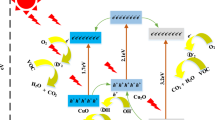Abstract
Materials that contain a photocatalyst have a semi-permanent capacity for removing harmful gases from the ambient air. It is the purpose of this study to investigate the photocatalytic activity of commercial paints containing TiO2 nanoparticles towards NO and NO2. Experiments were carried out in a stainless steel (30 m-3) walk-in type environmental chamber (Indoortron), under “real world setting” conditions of temperature, relative humidity, irradiation and pollutant concentrations. Two types of nanoparticle TiO2-containing paints were tested for their depolluting properties: a mineral silicate paint and a water-based styrene acrylic paint. The results showed a significant effect of TiO2-materials in reducing NOx. It was found that up to 74% of NO and 27% of NO2 were photo-catalytically degraded by the mineral silicate paint, while degradation percentage using the styrene acrylic paint reached 91% and 71% for NO and NO2, respectively. The photo-catalytic rate of NO on the mineral and styrene acrylic paint was calculated to 0.11 μg m-2 s and 0.18 μg m-2 s, respectively, indicating higher photocatalytic performance of the organic based material. The effect of relative humidity (RH) was also investigated. An increase of RH from 20% to 50% inhibited the NOx photocatalysis on the surface of the samples.
Similar content being viewed by others
References
A. Linsebigler, L. Guangquan, J. Yates, Chem. Rev. 95, 735 (1995)
T. Maggos, D. Kotzias, J. Bartzis, P. Leva, A. Bellintani, C. Vasilakos, Proceedings of 5th International Conference on Urban Air Quality, Valencia, Spain, 29–31 March 2005, p. 68
A. Fujishima, K. Hashimoto, T. Watanabe, TiO2 Photocatalysis: Fundamentals and Applications (BKC Inc., Japan, 1999)
K. Hashimoto, K. Wasada, N. Toukai, H. Kominami, Y. Kera, J. Photochem. Photobiol. 136, 103 (2000)
L. Cao, Z. Gao, S. Suib, T. Obee, S. Hay, J. Freihaut, J. Catal. 186, 253 (2000)
K. Rao, M. Subrahmanyam, P. Boule, Appl. Catal. B 49, 239 (2004)
S. Devahasdin, C. Fan, K. Li, D. Chen, J. Photochem. Photobiol. A 156, 161 (2003)
K. Hashimoto, K. Wasada, M. Osaki, E. Shono, K. Adachi, N. Toukai, H. Kominami, Y. Kera, Appl. Catal. B 30, 429 (2001)
J. Dalton, P. Janes, N. Jones, J. Nicholson, K. Hallam, G. Allen, Environ. Pollut. 120, 415 (2002)
H. Einaga, S. Futamura, T. Ibusuki, Appl. Catal. B 38, 215 (2002)
C. Ao, S. Lee, C. Mak, L. Chan, Appl. Catal. B 42, 199 (2003)
Author information
Authors and Affiliations
Corresponding author
Additional information
PACS
81.16.Hc; 81.65.Mq; 82.33.Tb; 82.50.Hp; 82.65.+r
Rights and permissions
About this article
Cite this article
Maggos, T., Bartzis, J., Leva, P. et al. Application of photocatalytic technology for NOx removal. Appl. Phys. A 89, 81–84 (2007). https://doi.org/10.1007/s00339-007-4033-6
Received:
Accepted:
Published:
Issue Date:
DOI: https://doi.org/10.1007/s00339-007-4033-6




